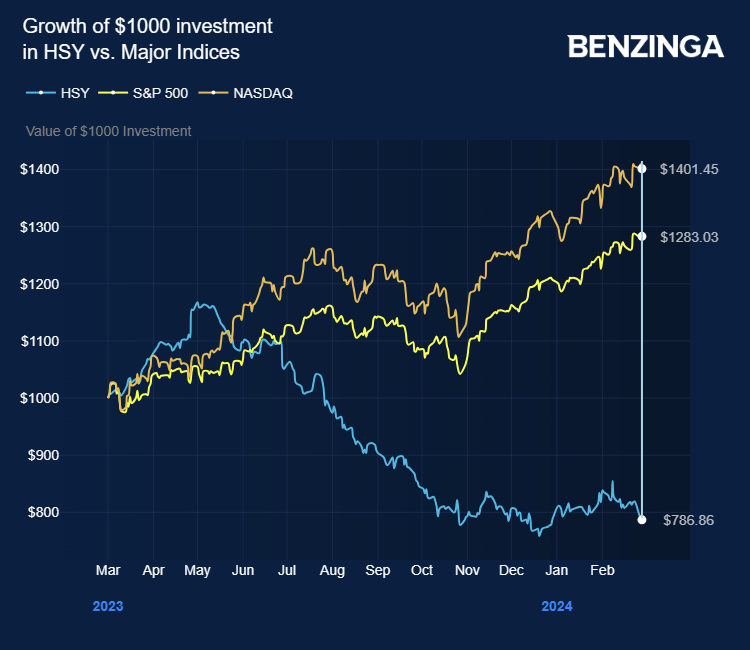Zinger Key Points
- Cocoa prices are close to all-time highs, despite this week's price drop.
- This puts cost and margin pressure on confectioners such as Hershey and Mondelez.
- Find out which stock just claimed the top spot in the new Benzinga Rankings. Updated daily— discover the market’s highest-rated stocks now.
After hitting a fresh record high on Monday, cocoa prices have slumped 13% — a sharp fall in just three days. But experts say the market remains in critical short supply, which is why Valentine’s Day chocolates were so expensive.
Meanwhile, hedge funds continue to build up long positions.
Despite the slump over the past three days, the U.S. cocoa futures price has jumped 43% to $5,999 a tonne since the start of the year. Four days ago it hit a fresh record high of $6,929.
This is particularly hard on companies such as Hershey Co HSY. The company reported earlier this month that it now expects flat earnings for 2024 due to higher raw materials costs.
“Historic cocoa prices are expected to limit earnings growth this year,” said Hershey CEO Michele Buck.
Shares in Hershey have fallen 8% to $186.25 since reporting its quarterly earnings and 2024 outlook on February 8.

Also Read: Choccy-Horror Show: Hedge Funds Pile In As Cocoa Soars To Record High
But what does this mean to the consumer? Ether you’ll pay more for your chocolate and candy bars, or pack sizes are smaller.
“Chocolate prices are about to rise — and bars and boxes will shrink too,” said Javier Blas, columnist for Bloomberg and ex-FT commodities correspondent on X.
The cocoa crisis has been a long time in the making. Most farmers in West Africa are overwhelmingly poor smallholders who lack the means to reinvest in their farms. Now, left with mainly old trees, farmers face lower yields and plants that are more susceptible to disease.
“Both factors are at play this year, and the upshot is a brutal gap between supply and demand, with the market heading for a deficit of between 300,000 and 500,000 tonnes. If confirmed, that would be the largest shortfall in 65 years,” said Blas.
While this doesn’t necessarily mean there’ll be a scarcity of candy bars on shelves — there are global warehoused stockpiles of cocoa — these stocks are wearing thin, adding to price pressure.
The International Cocoa Organization said: “It would be beneficial if all major players reconsider the structural issues being faced by the cocoa sector — aged trees, diseases, remunerative farm gate prices, climatic challenges, etc.”
The World Cocoa Foundation said it was addressing the imbalance between the wages earned by farmers in Cote d’Ivoire and Ghana, the world’s two largest cocoa producers, and prices charged to western consumers.
“Improving farmer income must remain at the forefront of everything that we do,” said Chris Vincent, president.
This Isn’t A Short-Term Problem
Better-paid farmers able to finally plant new trees won’t solve the problem overnight. It can take around five years before new cocoa trees start to produce seed pods.
This adds up to profits for traders and hedge funds who built up a near $9 billion net long position.
Still, there remains rising costs and pressure on margins for chocolate companies such as Hershey in the weeks leading up to Easter.
Shares in rival Mondelez International Inc. MDLZ — owner of Cadbury, Milka and Toblerone chocolate brands — are down 5% this month. Nestle SA NSRGF, owner of Toll Bar, is down 8% in February.
There is no exchange-traded fund to track the price of cocoa directly, but the Consumer Staples Select Sector SPDR XLP has been performing reasonably well over the past few months. Since mid-October, it has gained 12.6% to $74.56.
Read Now: Gasoline Pump Prices Near 1-Year High: Is This An Inflationary Threat?
Image: Shutterstock
Edge Rankings
Price Trend
© 2025 Benzinga.com. Benzinga does not provide investment advice. All rights reserved.
Trade confidently with insights and alerts from analyst ratings, free reports and breaking news that affects the stocks you care about.